Buyers Guide to Marine Isolation and Galvanic Transformers
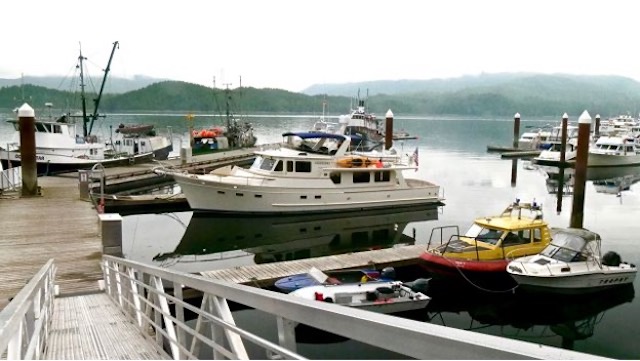
Bad or deteriorated marina wiring can cause everything from extreme corrosion on any exposed metal parts on your running gear and thru-hull fittings to electric shocks in the water and possibly inside the boat. Even a bad wiring system on a boat docked next to you can create problematic or perhaps dangerous electric current in the water around your boat.
Isolation transformers are insurance against these issues.
They provide isolation from shore power systems to enhance electrical safety and eliminate corrosion caused by stray currents. Some isolation transformers can also be used for raising the shore voltage to deal with voltage drop, keeping all your electrically-powered equipment aboard running as it should.
They also prevent your boat from sending an unintended electric shock into the water around it and vice versa. They also protect reversed polarity and shore voltage fluctuations which can damage or reset sensitive electronics.
Reverse polarity, possible due to inexpert wiring of the dock power, is eliminated because the transformer is self-polarizing. If you connect to a dock where the hot and neutral wires are reversed, the transformer will convert it to safe AC power aboard.
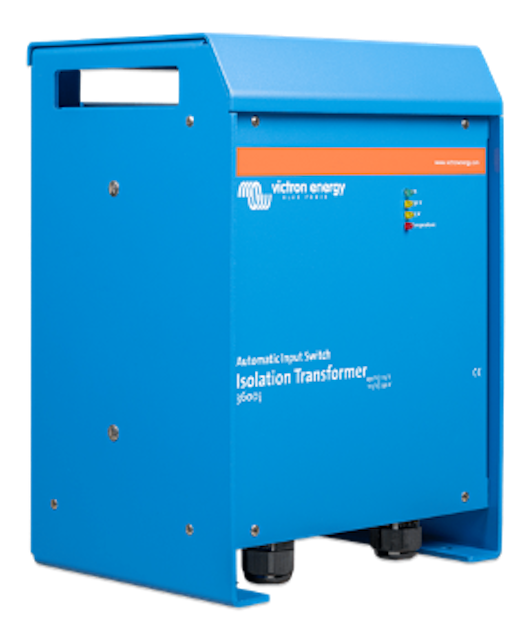
While the dangers of leaking electric current are most pronounced in older marinas or remote locations where wiring codes are unenforced or non-existent, even the most modern harbors can be subject to the issue due to a broken wire or faulty connector.
Many premium-class yachts have isolation transformers installed as original equipment.
But if your boat has a shore-power hookup and no isolation transformer, it’s a good idea to invest in one.
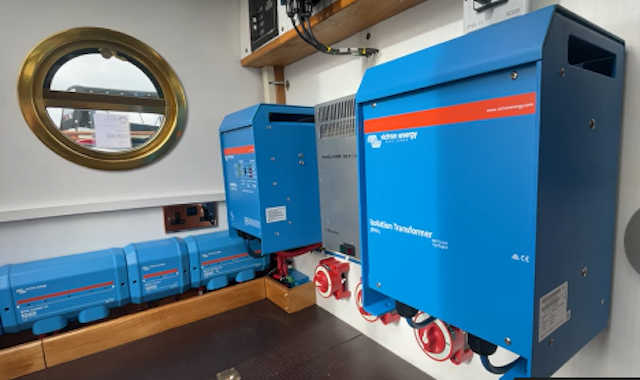
Galvanic Isolators
Another approach to this issue is the galvanic isolator, a smaller, lighter and less expensive solution that is more suitable for small boats that spend considerable time in the water.
The primary aim if the galvanic isolator is to prevent stray currents from prematurely eroding zincs, running gear and other metal parts below the waterline. In this limited role, they are cost effective and are also compact enough to fit even into the bilge area of a bass boat or center console.
A basic galvanic isolator costs around $300, a wise investment for even a smaller boat kept in the water at a marina or frequently anchored close to other boats that might be leaking stray current from generators or from shore power.
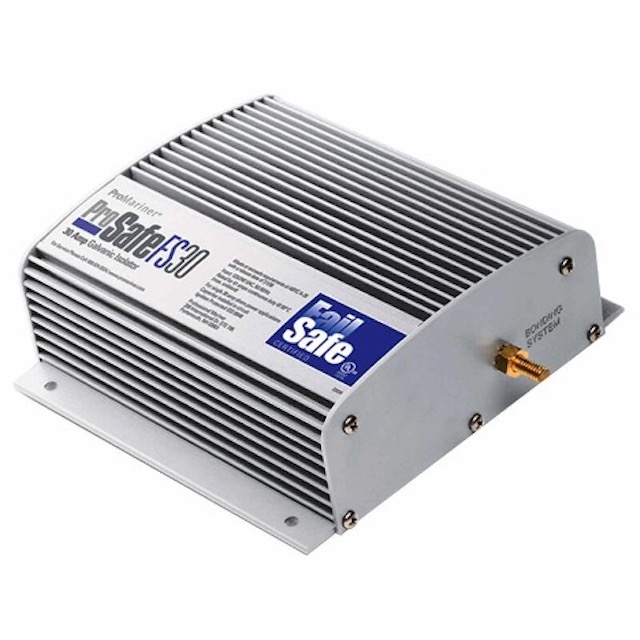
cases. (Promariner)
When installed correctly, the galvanic isolator introduces a low DC voltage drop in the green grounding conductor. This stops any galvanic flow of electricity and protects your boat from DC electricity coming from your neighbors.
How They Work
Isolation transformers work by electromagnetic induction. Induction occurs when a circuit with an alternating current flowing through it generates current in another circuit simply by being placed nearby. Electricity flowing from the dockside power supply through the incoming coil creates electricity in the onboard coil with no hard-wired physical connection. No connection means no galvanic corrosion and no shock dangers jumping from one system to the other.
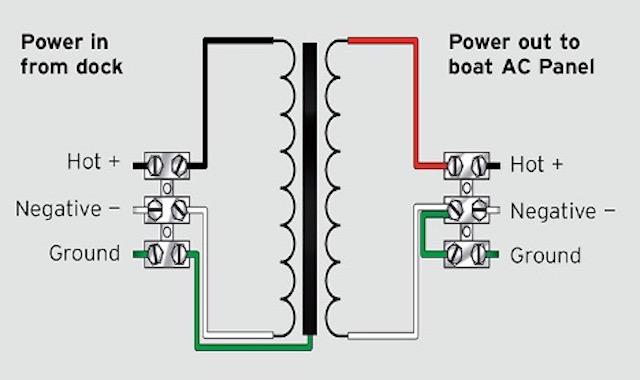
So, why don’t all well-equipped boats come with an isolation transformer as standard equipment?
First, the traditional models are both expensive and heavy. The classic 120V/30A transformers weigh in close to 100 pounds, while typical 240V/50A unit scaled almost 300 pounds. While the weight would not be an issue at all on a yacht, it might be on a 25’ to 35’ weekender. (Most boats under 25’ are trailered rather than docked in a wet slip, so the devices make less sense for them.)
Traditional isolation transformers also take a good bit of space that may be hard to come by in smaller boat bilge or engine compartments.
And last but not least, they are relatively expensive, priced at $2,000 to $4,000, more for larger units suitable for larger yachts.
Also, these traditional transformers are not that versatile and often require complicated switching arrangements or rewiring to allow them to perform multiple tasks like boosting voltages or converting voltages from different countries.
The New Breed of Isolation Transformers
Recent changes to ABYC E-11 AC and DC Electrical Systems for Boats now permit the use of high frequency transformers allowing designers to build smaller transformers for pleasure craft. Some of these models, both lighter and less expensive, are now on the market. They are not cheap—some of the lightest (20 pounds) are also the most expensive ($2,000+) but they are a compact solution to preventing current flow problems for boats in wet slips for extended periods.
How Are Isolation Transformer Wired?
Both isolation transformers and galvanic isolators are always installed on the AC side of your boat’s electrical system. However, when it comes to isolation transformers, you’ll want a very secure place to mount them near your shore power input line because of the relative weight.
Disconnect from shore power and generator before doing any wiring, of course. Cut the shore power input line and connect it to the transformer. This forces any AC power to go through the transformer first. By doing this, you essentially create your own onboard power source. The boat’s power supply then gets connected to the output of the transformer.
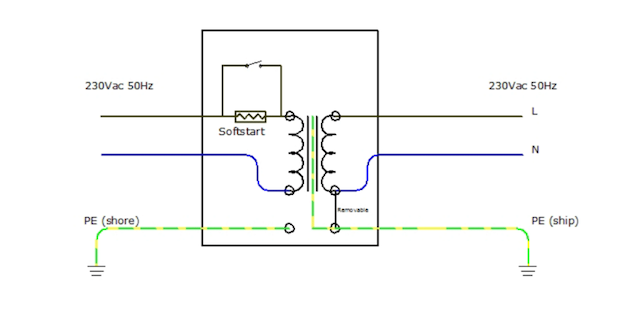
This separates the ground systems and provides full isolation.
Bottom Line
Whether you choose a traditional isolation transformer, a high-frequency compact isolation transformer or a galvanic isolator—or all three—adding this equipment to your boat will make it safer and take away one of the potential issues of enjoying life afloat. Here’s a look at some that are currently available.
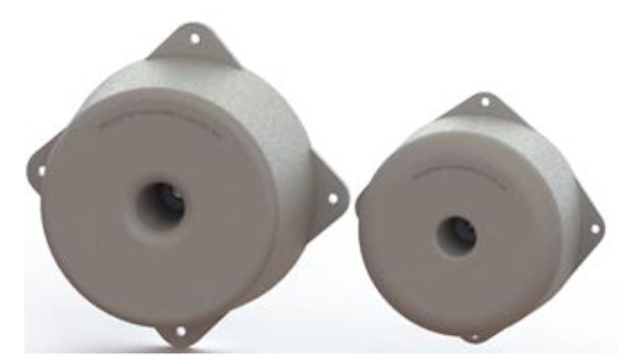
Bridgeport Magnetics Marine Pucks are toroidal (ring shaped) isolation transformers fully embedded in solid epoxy resin inside a cup-shaped non-metallic enclosure. They are sealed hermetically and can be mounted onto a deck or a bulkhead. They are very compact, with a 3.6 KVA 30 amp model just 10” in diameter and 5” thick, weighing 45 lb (20.4 kg). A 6 KVA 25 amp model 12.6’ x 6.5” weighs 80 lb (40.8 kg), and for 12 KVA the 50 amp setup is a pair of the 6 KVA’s, weighing 160 lb (72.6 kg).
The company says toroidal transformers are up to 50% lighter and much smaller than standard isolation transformers.
They are also silent—no annoying hum when connected to shore power. And the non-metallic enclosure combined with the solid epoxy potting compound eliminates shock and fire hazards due to broken or loose conductors touching a metallic case besides effectively preventing sea water from entering the transformer: https://www.bridgeportmagnetics.com
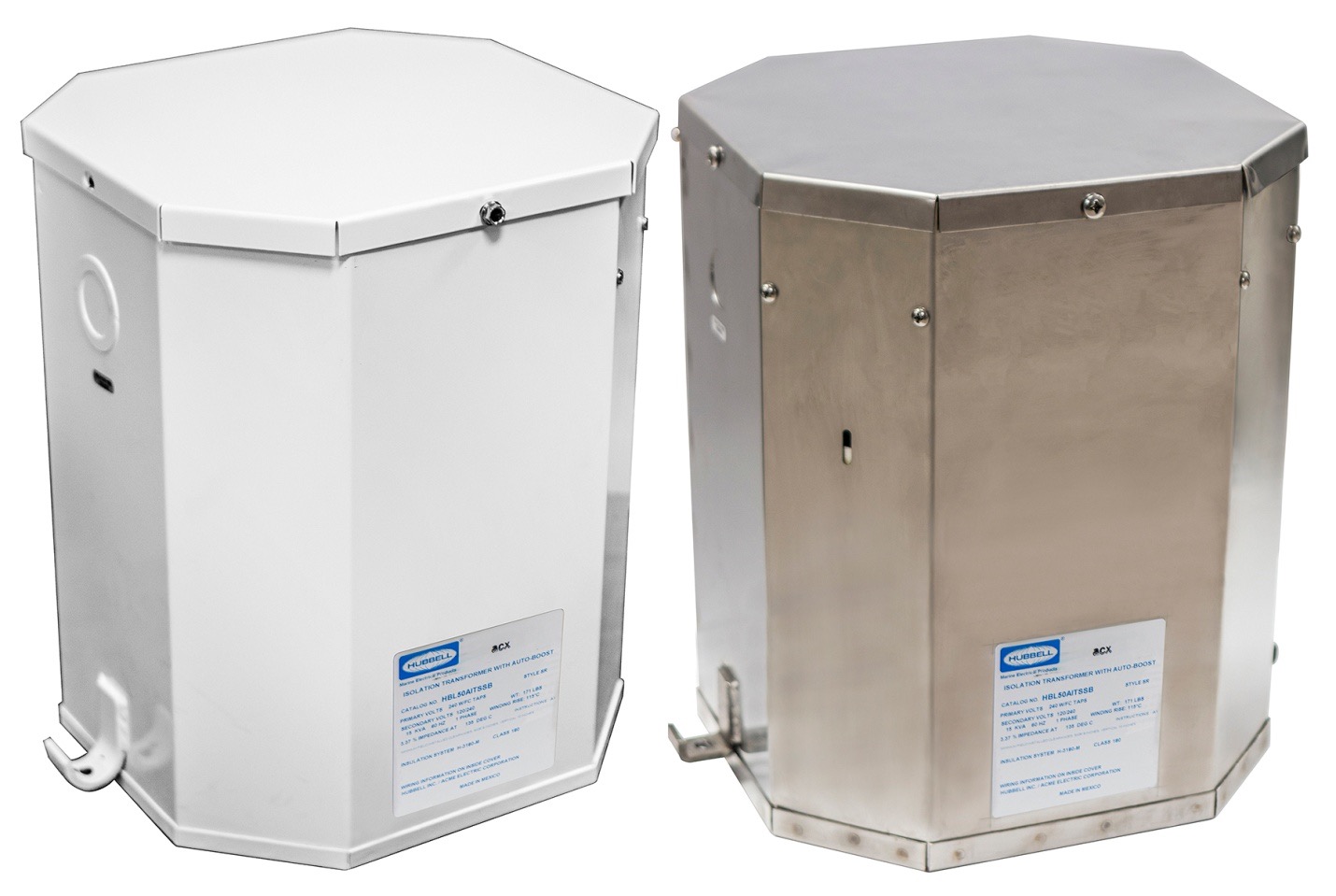
Hubbell Isolation Transformers measure shore power on startup and if the reading falls significantly the device instantly boosts output by up to 12.5% to ensure a constant flow. The 15kVA model weighs 210 lbs (95.3 kg). The 25kVA measures 18.44" H x 16.13" W x 13.34" D. and weighs 310 lbs (140.6 kg). About $2,650: www.hubbell-marine.com.
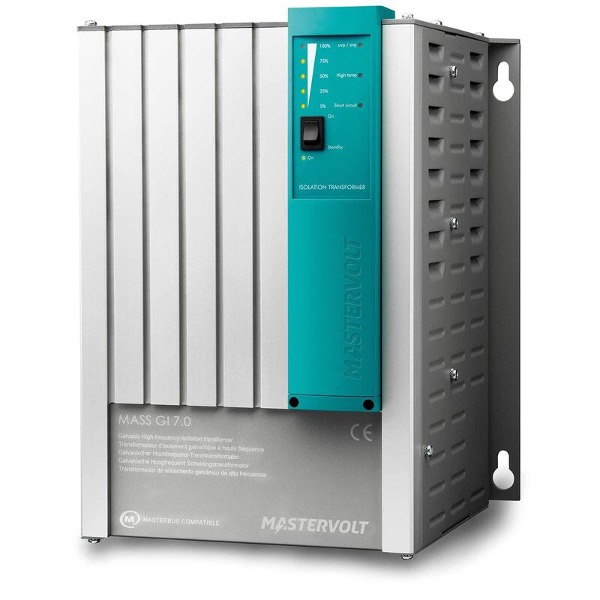
The Mastervolt GI 7 is one of the lightest full-function isolation transformers on the market, weighing just 22 lb. (10 kg). It’s an extremely small isolation transformer measuring 13.4”x 10.3” x 9.8” (340 x 261 x 250 mm) that includes the latest high-frequency electronics switch technology, per the company. Suitable for 120V and 230V AC systems, its capacity can be parallel-coupled for higher capacity. It’s compatible with 90 to 255V AC and 45 to 654Hz frequency.
It does not vibrate or hum like some larger units, and the integrated “soft start” technology manages current surge when first hooked up to shore power. It can be linked to a network for remote monitoring. About $2090: Mastervolt.
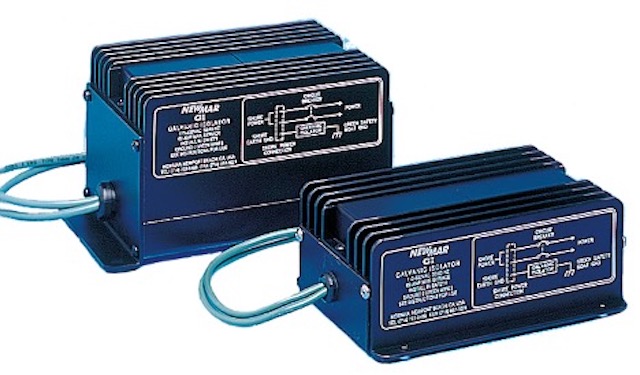
Newmar Electronics galvanic isolators are a very compact form of protection for any boat’s zincs, reducing replacement and haulout costs. An oversized capacitor provides a low impedence path for stray AC current and improved galvanic protection according to the company, and installation is quick and easy even on boats with limited space.
They’re available in both 30 and 50 amp models, with the smaller about $280, the larger about $335: Newmar Electronics.
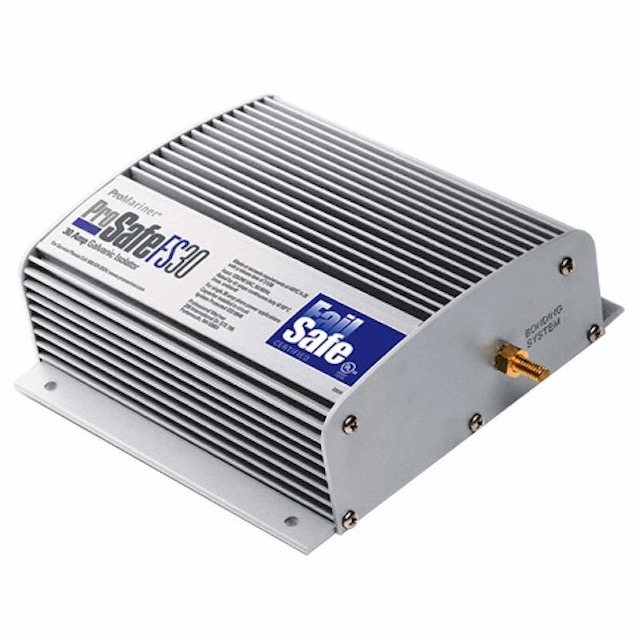
ProSafe FS (Fail Safe) Galvanic Isolators maximize anode life and protect metal parts on boats against galvanic corrosion. Semiconductor platforms ensure that your boat's AC ground will continue to work in the unlikely event the isolator fails. Terminals are gold-plated for long life.
The technology maintains AC safety ground and solves the most common forms of corrosion and premature zinc loss within a boat’s bonding system. About $320: https://www.promariner.com